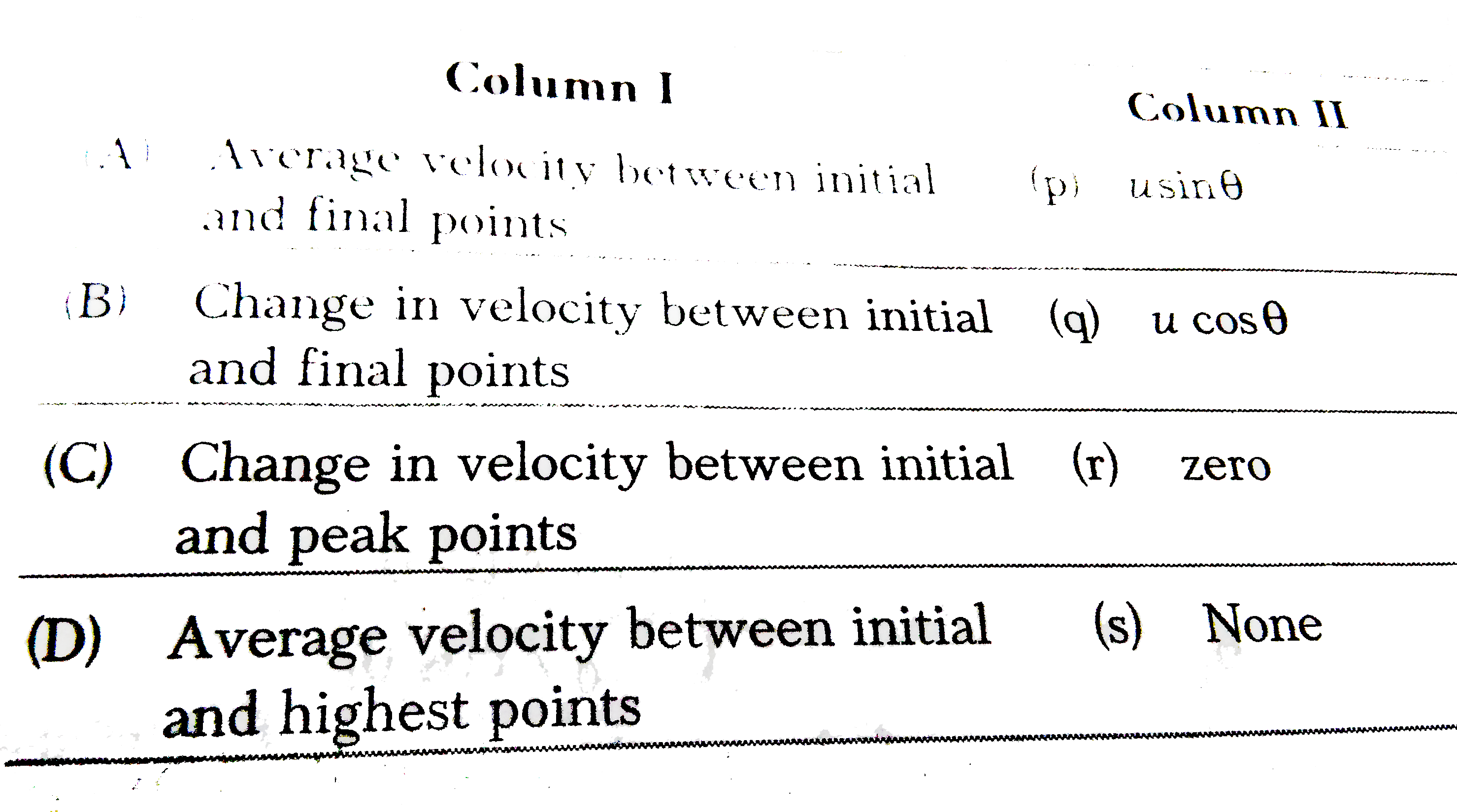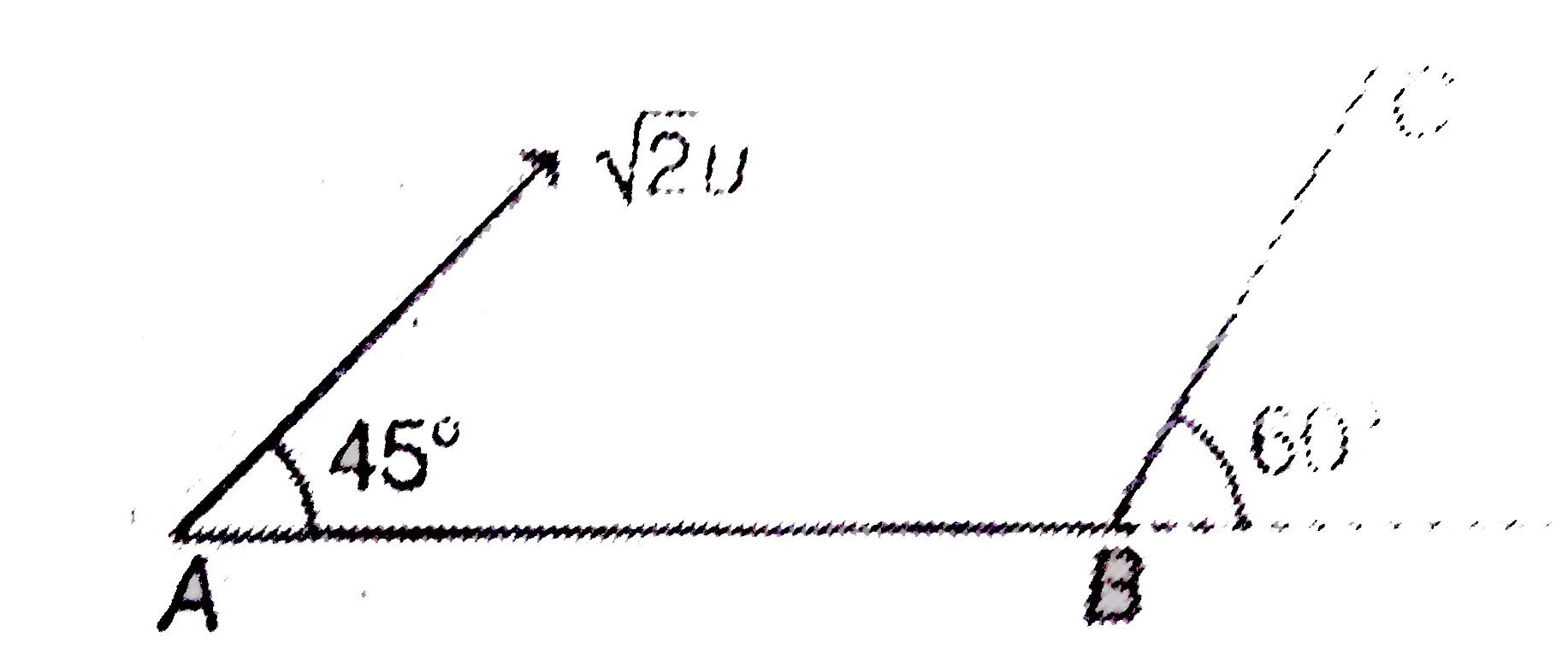A particle is projected from a point P with a velocity v at an angle θ with horizontal. At a certain point Q it moves at right angles to its initial direction. Then
velocity of particle at Q is v sinθ
velocity of particles at Q is v cotθ
time of flight from P→Q is (v/g)cosecθ
time of flight from P→Q is (v/g)secθ
The correct Answer is:B, C
To solve the problem step by step, we will analyze the motion of the particle projected at an angle θ with an initial velocity v and determine the conditions at point Q where the particle moves at right angles to its initial direction.
Step 1: Understand the initial conditions
The particle is projected from point P with an initial velocity v at an angle θ with the horizontal. The initial velocity can be broken down into horizontal and vertical components:
- Horizontal component: vx=vcosθ
- Vertical component: vy=vsinθ
Step 2: Analyze the situation at point Q
At point Q, the particle's velocity is at right angles to its initial direction. This means that the angle between the velocity vector at point Q and the initial velocity vector is 90∘.
Let the velocity at point Q be v1. Since the velocity vector at Q is perpendicular to the initial velocity vector, we can express this relationship mathematically.
Step 3: Relate the components of the velocities
The horizontal component of the velocity remains unchanged throughout the motion (assuming no air resistance). Therefore, we have:
vcosθ=v1cos(90∘−θ)=v1sinθ
From this equation, we can solve for v1:
v1=vcosθsinθ=vcotθ
Step 4: Determine the vertical component of the velocity at point Q
The vertical component of the velocity at point Q can be expressed as:
v1y=v1sinθ=(vcotθ)sinθ=vcosθ
However, since the particle is moving downwards at point Q, we consider this vertical component to be negative:
v1y=−vcosθ
Step 5: Use the first equation of motion to find time of flight
Using the first equation of motion:
v1y=vy−gt
Substituting the values we have:
−vcosθ=vsinθ−gt
Rearranging gives:
gt=vsinθ+vcosθ
Factoring out v:
gt=v(sinθ+cosθ)
Thus, we can express time t as:
t=v(sinθ+cosθ)g
Step 6: Finalize the time of flight
The time of flight from point P to point Q is given by:
t=vg⋅1sinθ
This simplifies to:
t=vgsinθ
Conclusion
From the analysis, we conclude:
- The velocity at point Q is v1=vcotθ.
- The time of flight from P to Q is t=vgsinθ.
The particle is projected from point P with an initial velocity v at an angle θ with the horizontal. The initial velocity can be broken down into horizontal and vertical components:
- Horizontal component: vx=vcosθ
- Vertical component: vy=vsinθ
At point Q, the particle's velocity is at right angles to its initial direction. This means that the angle between the velocity vector at point Q and the initial velocity vector is 90∘.
The horizontal component of the velocity remains unchanged throughout the motion (assuming no air resistance). Therefore, we have:
vcosθ=v1cos(90∘−θ)=v1sinθ
From this equation, we can solve for v1:
v1=vcosθsinθ=vcotθ
The vertical component of the velocity at point Q can be expressed as:
v1y=v1sinθ=(vcotθ)sinθ=vcosθ
However, since the particle is moving downwards at point Q, we consider this vertical component to be negative:
v1y=−vcosθ
Using the first equation of motion:
v1y=vy−gt
Substituting the values we have:
−vcosθ=vsinθ−gt
Rearranging gives:
gt=vsinθ+vcosθ
Factoring out v:
gt=v(sinθ+cosθ)
Thus, we can express time t as:
t=v(sinθ+cosθ)g
The time of flight from point P to point Q is given by:
t=vg⋅1sinθ
This simplifies to:
t=vgsinθ
From the analysis, we conclude:
- The velocity at point Q is v1=vcotθ.
- The time of flight from P to Q is t=vgsinθ.
Topper's Solved these Questions
- PROJECTILE MOTIONBOOK - DC PANDEY ENGLISHCHAPTER - PROJECTILE MOTIONEXERCISE - Level - 2 Subjective
10 Videos
- PROJECTILE MOTIONBOOK - DC PANDEY ENGLISHCHAPTER - PROJECTILE MOTIONEXERCISE - Level - 2 Single Correct
10 Videos
- MOTION IN A PLANEBOOK - DC PANDEY ENGLISHCHAPTER - MOTION IN A PLANEEXERCISE - (C )Medical entrances gallery
32 Videos
- PROPERTIES OF MATTERBOOK - DC PANDEY ENGLISHCHAPTER - PROPERTIES OF MATTEREXERCISE - Integer
8 Videos
Similar Questions
A particle is projected from a point O with velocity u in a direction making an angle α upward with the horizontal. AT P , it is moving at right angles to its initial direction of projection . Its velocity at P is .
View SolutionA particle is projected from the ground with velocity u making an angle θ with the horizontal. At half of its maximum heights,
View Solution
Knowledge Check
A particle is projected from the ground with an initial speed v at an angle θ with horizontal. The average velocity of the particle between its point of projection and highest point of trajectory is [EAM2013]
AucosθBu2√1+cos2θCu2√1+2cos2θDu2√1+3cos2θ
A particle is projected form ground with velocity u ar angle θ from horizontal. Match the following two columns.

View SolutionA particle is projected with a velocity u making an angle θ with the horizontal. At any instant its velocity becomes v which is perpendicular to the initial velocity u. Then v is
View SolutionA particle is projected with velocity v at an angle θ aith horizontal. The average angle velocity of the particle from the point of projection to impact equals
View SolutionA particle of mass m is projected with a velocity v at an angle of θ with horizontal. The angular momentum of the particle at the highest point of its trajectory is equal to :
View SolutionA particle is projected from a point A with velocity √2u an angle of 45∘ with horizontal as shown in figure. It strikes the plane BC at right angles. The velocity of the particle at the time of collision is

View SolutionA particle is fired with velocity u making angle θ with the horizontal.What is the change in velocity when it is at the highest point?
View SolutionA particle is projected with velocity u at angle θ with horizontal. Find the time when velocity vector is perpendicular to initial velocity vector.
View Solution
